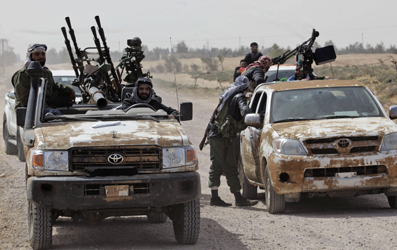
The most common pseudo-military vehicle in the world of the Morrow Project is usually a “Technical” – an open-backed civilian pickup truck or four-wheel drive vehicle mounting some form of heavy weapon: a machine gun, light anti-aircraft gun, recoilless rifle, or other support weapon. Maxwell’s Militia is the most widespread user, but this weapons platform is available to almost any group that has Technology Level C.
Organization
There is very little sophistication in the use of “Technicals”.
1. The basic unit is the vehicle and its mounted squad: a group of 4 to 8 fighters with their gear and supplies.
2. the vehicles usually operate in groups of 4 or more
3. There is only one tactical formation: the ‘extended line”
SOP (Standard Operating Procedure)
1. “Maintain an extended line abreast”
2. “Keep your neighbours just in sight, but no closer”
3. “Move to the sound of the guns”
4. “Dismount when you see the enemy”
5. “”When you come under fire, stop and fire back”
How this works in combat
Technicals always move abreast and maintain a distance between them such that each unit can just see the vehicles on either side (obviously, this distance varies dependent on terrain etcetera). The intended result of this movement formation is that the enemy will be easily flanked.
The vehicles that first encounter the enemy will immediately halt and lay down suppressive fire. The momentum of the advance will cause the other vehicles to advance a small distance before they can react and turn towards the firefight – this will result in a flanking position. There is no need for radio communication or formal orders, each unit turns towards the gunfire and (while maintaining formation) automatically positions itself on the flanks or to the rear of the enemy position
Once the fighters can see the enemy, they dismount and form another extended line about 3 or 4 metres in front of their Technical. The unit (dismounted fighters and vehicle) then sweeps forward until they come under fire – at this point the fighters take cover and the vehicle stops while the squad’s heavy weapon is used. Meanwhile the other Technicals (and their fighters) close in on the position (again without formal coordination – just guided by the sound of gunfire).
Note: The squad leader remains with the vehicle (and may be the main gunner). He coordinates his fighters and driver by voice commands. Professional military might consider this less than optimal, assuming that the squad leader should join the dismounted fighters and leave a trusted subordinate to manouver the vehicle. But it must be remembered that the leader usually owes his position to the fact that his family owns the Technical – an immensely valuable and almost irreplaceable asset. He would be foolish to risk losing control. All squad leaders agree that ambitious subordinates should be kept IN FRONT of the machine gun










